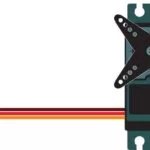Don’t Expect Your RC Servos to Last More Than 2 Years


Servos are one of the most important components in an RC car.
Without servos, you can’t turn the tires of your RC car, and obviously, this makes your RC car utterly useless.
So, let’s begin our journey into the world of RC servos, how long they can remain functional, how to maintain your servos, and what makes them decline in functionality faster.


What Is The Lifespan Of An RC Servo?
The lifespan of an RC servo strictly depends on the usage of your RC car.
If you were to use your RC car in ideal conditions, and also in a manner that doesn’t put too much strain on the servo itself, you can expect your RC servo to last 20+ years.
Under rough conditions and vigorous use, your servo could last just one year.
It should also be noted that a servo’s functionality and lifespan usually and largely depends on the condition of their bearings.
Do RC Servos Go Bad?
RC servos, depending on how much strain you put them under, can go bad relatively fast and easily.
In order to avoid such a thing, please follow the link below to another article with information that will keep your servos healthy.
4 Reasons An RC Servo Go Bad (Inspect&Fix)
What Are The Signs That Your Servo Is Going Bad?
You may be hearing a strange humming noise emanating from your servo when you supply it with power, and of course, this could be making you very concerned about its health.
Not to fear! We have put together a small list of signs to look out for when your servo is operating.
- As stated above, if you hear a humming emanating from your servo, coupled with the fact that it’s no longer functioning, this means that there is a gear problem, and you should get it fixed or replaced.
- If your servo has become noisier than usual, it means that the bearings inside of the servo have worn out or are wearing out.
- If you find that your servo is drawing a high amount of amps, it could possibly mean that your servo has an internal component issue. You should send your servo in to a professional for repairs immediately.
- Servo equipment faults can often be discovered in the form of alarms. If you notice any alarms from your servo, you may investigate and attempt to fix it on your own, or you may send it in to a professional for repairs.
How To Increase The Lifespan Of Your Servo
To ensure a long lifespan for your servo, taking good care of it is one of the most important things you can possibly do for it.
One of the most basic mistakes is tightening your servo too much when installing it in your RC car. Please make sure that the servo is not installed too tightly.
The servo will have a vibration-proof washer to mitigate the possibility of the equipment being damaged by the running of the machine that the servo is in, so make sure that the servo is not too tightly installed.
Another useful activity to take part in is regularly checking the condition of the bearings in your servo. If they seem to be getting worn out, replacing the bearings will be essential to the longevity of your servo.
Our final piece of advice is to make sure to clean your servo regularly. Try not to get liquids or any debris inside of the servo.
What Shortens The Life Of An RC Servo?
Many different activities that you do with your RC car can damage and shorten the lifespan of your servo.
We’re going to list a few things that you should always be wary of and try to avoid as much as you can, if at all possible.
As a result, you will also learn what contributes to the declining condition of a servo
- When installing your servo, please pay attention to what you’re doing and try not to rush through the process.
Doing so could cause you to connect things where they shouldn’t be, and this could result in a failure of equipment, which could actually cause harm to your servo.
- Always be sure to test the wires you’re using to avoid shortages or spikes in power.
This could damage and/or completely break your servo, and repairs could be pricey, so please take great care to check your equipment before and after installation.
- It’s also important to note that a bad drive can result in a spike in power, and this could completely fry the circuitry of your servo.
Please always test your equipment before installation, as this is simply good practice and will save you time and money in the long run.
- If you must replace your servo motor gear, using ceramic-based lubricant and avoiding mineral-based lubricant is essential for avoiding deterioration of the plastic gears.
Always keep the proper lubricant on-hand, because if you do make the simple mistake of using the wrong lubricant, you can severely damage your servo.
- The standard receiver voltage for most servos is 4.8V, so never try to swap out the standard voltage for something higher, as this can burn out your servo and cause it to stop working indefinitely.
Please check what voltage the receiver on your servo is compatible with. Even though the standard is 4.8V, some may be more, so avoid cranking up the voltage just to give your servo more power.
Common Servo Issues
There are some servo problems that we couldn’t cover in this article, but rest assured, we’ve got you covered in the article linked below!
How RC Servos Work
To understand how an RC servo works is to better understand how to solve a problem that may arise during the use of your servo.
A servo works by utilizing an electric motor, a potentiometer, and a control circuit. The potentiometer’s job is to create a variable voltage from a fixed-voltage source, which allows for the control circuit to regulate how much movement is happening and in which direction.
When the shaft of the motor reaches the position that it needs to be in, the power supply is immediately cut, ceasing the shaft’s movement. When power is reintroduced to the motor, the shaft will then begin to move to the desired position again, which is once again dictated by the voltage that is being received.
The speed of the motor is dictated by the position of the shaft’s angle. If the shaft’s actual position is closer to the desired position, it will move slower to the desired position. If the shaft is further from the desired position, it will move there faster.
As you can see, servos are very efficient, very useful components.
Best RC Servo For Steering
To get the most maneuverability out of your RC car, getting the best servo for your model is a great start.
Our pick for the best RC servo – The ProTek RC 160T Low Profile High Torque Metal Gear Servo High Voltage/Metal Case
With 216 oz-in of torque, this servo is bound to please. This servo also has 0.08 transit speed 6.0V. This servo will guarantee great maneuverability and keep you satisfied for the duration of your time spent with it.





